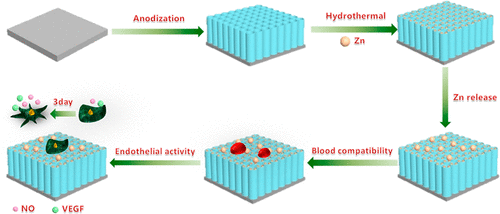当前位置:
X-MOL 学术
›
ACS Biomater. Sci. Eng.
›
论文详情
Our official English website, www.x-mol.net, welcomes your
feedback! (Note: you will need to create a separate account there.)
Improved Blood Compatibility and Endothelialization of Titanium Oxide Nanotube Arrays on Titanium Surface by Zinc Doping
ACS Biomaterials Science & Engineering ( IF 5.4 ) Pub Date : 2020-03-11 , DOI: 10.1021/acsbiomaterials.0c00187 Changjiang Pan 1 , Youdong Hu 2 , Zhihao Gong 1 , Ya Yang 2 , Sen Liu 1 , Li Quan 1 , Zhongmei Yang 1 , Yanchun Wei 1 , Wei Ye 1
ACS Biomaterials Science & Engineering ( IF 5.4 ) Pub Date : 2020-03-11 , DOI: 10.1021/acsbiomaterials.0c00187 Changjiang Pan 1 , Youdong Hu 2 , Zhihao Gong 1 , Ya Yang 2 , Sen Liu 1 , Li Quan 1 , Zhongmei Yang 1 , Yanchun Wei 1 , Wei Ye 1
Affiliation

|
Titanium dioxide nanotube arrays are widely used in biomaterials due to their unique tubular structure and tunable biocompatibility. In the present study, titanium oxide nanotube arrays with different diameters were prepared on the titanium surface by anodization, followed by zinc doping using hydrothermal treatment to enhance the biocompatibility. Both the nanotube dimensions and zinc doping had obvious influences on the hydrophilicity, protein adsorption, blood compatibility, and endothelial cell behaviors of the titanium surface. The increase of the diameter and zinc doping can improve the hydrophilicity of the titanium surface. The increase of nanotube diameter could reduce the albumin adsorption while increasing the fibrinogen adsorption. However, zinc doping can simultaneously promote the adsorption of albumin and fibrinogen, and the effect was more obvious for albumin. Zinc doping can significantly improve the blood compatibility of the titanium oxide nanotubes because it cannot only increase the activity of cyclophosphate guanylate (cGMP) but also significantly reduce the platelets adhesion and hemolysis rate. Moreover, it was also found that both the smaller diameter and zinc doping nanotubes can enhance the endothelial cell adhesion and proliferation as well as up-regulate the expression of NO and VEGF. Therefore, the zinc doped titanium dioxide nanotube array can be used to simultaneously improve the blood compatibility and promote endothelialization of the titanium-based biomaterials and implants, such as intravascular stents.
中文翻译:

锌掺杂改善钛表面氧化钛纳米管阵列的血液相容性和内皮化
二氧化钛纳米管阵列因其独特的管状结构和可调节的生物相容性而广泛用于生物材料。在本研究中,通过阳极氧化在钛表面制备具有不同直径的氧化钛纳米管阵列,然后使用水热处理来掺杂锌以增强生物相容性。纳米管尺寸和锌掺杂都对钛表面的亲水性,蛋白质吸附,血液相容性和内皮细胞行为有明显影响。直径的增加和锌的掺杂可以改善钛表面的亲水性。纳米管直径的增加可以减少白蛋白的吸附,同时增加纤维蛋白原的吸附。但是,锌掺杂可以同时促进白蛋白和纤维蛋白原的吸附,白蛋白的作用更为明显。锌掺杂可以显着改善二氧化钛纳米管的血液相容性,因为它不仅可以提高环磷酸鸟苷酸(cGMP)的活性,而且可以显着降低血小板的粘附性和溶血速率。此外,还发现较小直径和掺杂锌的纳米管均可以增强内皮细胞的粘附和增殖以及上调NO和VEGF的表达。因此,锌掺杂的二氧化钛纳米管阵列可用于同时改善血液相容性并促进钛基生物材料和植入物如血管内支架的内皮化。锌掺杂可以显着改善二氧化钛纳米管的血液相容性,因为它不仅可以提高环磷酸鸟苷酸(cGMP)的活性,而且可以显着降低血小板的粘附性和溶血速率。此外,还发现较小直径和掺杂锌的纳米管均可以增强内皮细胞的粘附和增殖以及上调NO和VEGF的表达。因此,锌掺杂的二氧化钛纳米管阵列可用于同时改善血液相容性并促进钛基生物材料和植入物如血管内支架的内皮化。锌掺杂可以显着改善二氧化钛纳米管的血液相容性,因为它不仅可以提高环磷酸鸟苷酸(cGMP)的活性,而且可以显着降低血小板的粘附性和溶血速率。此外,还发现较小直径和掺杂锌的纳米管均可以增强内皮细胞的粘附和增殖以及上调NO和VEGF的表达。因此,锌掺杂的二氧化钛纳米管阵列可用于同时改善血液相容性并促进钛基生物材料和植入物如血管内支架的内皮化。还发现更小的直径和锌掺杂的纳米管都可以增强内皮细胞的粘附和增殖以及上调NO和VEGF的表达。因此,锌掺杂的二氧化钛纳米管阵列可用于同时改善血液相容性并促进钛基生物材料和植入物如血管内支架的内皮化。还发现较小直径和锌掺杂的纳米管都可以增强内皮细胞的粘附和增殖以及上调NO和VEGF的表达。因此,锌掺杂的二氧化钛纳米管阵列可用于同时改善血液相容性并促进钛基生物材料和植入物如血管内支架的内皮化。
更新日期:2020-04-23
中文翻译:

锌掺杂改善钛表面氧化钛纳米管阵列的血液相容性和内皮化
二氧化钛纳米管阵列因其独特的管状结构和可调节的生物相容性而广泛用于生物材料。在本研究中,通过阳极氧化在钛表面制备具有不同直径的氧化钛纳米管阵列,然后使用水热处理来掺杂锌以增强生物相容性。纳米管尺寸和锌掺杂都对钛表面的亲水性,蛋白质吸附,血液相容性和内皮细胞行为有明显影响。直径的增加和锌的掺杂可以改善钛表面的亲水性。纳米管直径的增加可以减少白蛋白的吸附,同时增加纤维蛋白原的吸附。但是,锌掺杂可以同时促进白蛋白和纤维蛋白原的吸附,白蛋白的作用更为明显。锌掺杂可以显着改善二氧化钛纳米管的血液相容性,因为它不仅可以提高环磷酸鸟苷酸(cGMP)的活性,而且可以显着降低血小板的粘附性和溶血速率。此外,还发现较小直径和掺杂锌的纳米管均可以增强内皮细胞的粘附和增殖以及上调NO和VEGF的表达。因此,锌掺杂的二氧化钛纳米管阵列可用于同时改善血液相容性并促进钛基生物材料和植入物如血管内支架的内皮化。锌掺杂可以显着改善二氧化钛纳米管的血液相容性,因为它不仅可以提高环磷酸鸟苷酸(cGMP)的活性,而且可以显着降低血小板的粘附性和溶血速率。此外,还发现较小直径和掺杂锌的纳米管均可以增强内皮细胞的粘附和增殖以及上调NO和VEGF的表达。因此,锌掺杂的二氧化钛纳米管阵列可用于同时改善血液相容性并促进钛基生物材料和植入物如血管内支架的内皮化。锌掺杂可以显着改善二氧化钛纳米管的血液相容性,因为它不仅可以提高环磷酸鸟苷酸(cGMP)的活性,而且可以显着降低血小板的粘附性和溶血速率。此外,还发现较小直径和掺杂锌的纳米管均可以增强内皮细胞的粘附和增殖以及上调NO和VEGF的表达。因此,锌掺杂的二氧化钛纳米管阵列可用于同时改善血液相容性并促进钛基生物材料和植入物如血管内支架的内皮化。还发现更小的直径和锌掺杂的纳米管都可以增强内皮细胞的粘附和增殖以及上调NO和VEGF的表达。因此,锌掺杂的二氧化钛纳米管阵列可用于同时改善血液相容性并促进钛基生物材料和植入物如血管内支架的内皮化。还发现较小直径和锌掺杂的纳米管都可以增强内皮细胞的粘附和增殖以及上调NO和VEGF的表达。因此,锌掺杂的二氧化钛纳米管阵列可用于同时改善血液相容性并促进钛基生物材料和植入物如血管内支架的内皮化。











































 京公网安备 11010802027423号
京公网安备 11010802027423号